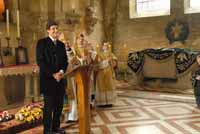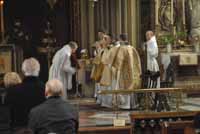On 20 April, 2008, on the occasion of the bicentenary of the birth of Napoleon III, St Michael's Abbey in Farnborough, Hampshire, witnessed a ceremony the like of which probably not seen since the funeral of the Empress Eugénie in 1920.
The Right Reverend Abbot, Dom Cuthbert Brogan OSB and the Benedictine monks of the abbey who watch over the imperial tombs really “pulled out all the stops”. The first thing visitors (including a large delegation from the Souvenir Napoléonien) and those invited by the Prince Napoléon saw was an immense tricolour. The monks were decked out in the sumptuous festal robes presented to them by the Empress Eugénie. The mayor of Farnborough (with his imposing mayoral chain) was present at the arrival (at 9am) of the Prince Napoléon and members of the imperial family, namely, the Princesse Napoléon, the Prince Jérôme Napoléon and the Princesse Caroline Napoléon, and the prestigious delegation comprising Madame Hélène Carrère d'Encausse, perpetual secretary to the Académie française, Monsieur Alain Decaux, of the Académie française, General Gobillard, gouvernor of the Invalides, the General “chef de cabinet” of the Grand Chancellory of the Légion d'Honneur, Madame the Superintendant of the Maisons d'éducation of the Légion d'Honneur accompanied by the director of the Maison de Saint-Germain and the director of music, the President of the Médaillés militaires and two of its vice presidents, the director of the Fondation Napoléon, representing the Prince d'Essling, president, etc. These prestigious invitees were soon joined by the Prince Murat, the Comte Walewski along with several other members of his family, the Marquis d'Albufera, and some members of the families of the Duc de Magenta and of the Comte Rouher. The Spanish ambassador, personal representative of King Juan Carlos 1, was also present, along with the Rumanian ambassador. Lastly came the French ambassador, personal representative of the French President. For the first time since 1873, France was officially represented within the Abbey grounds and later at the tomb of Napoleon III.



